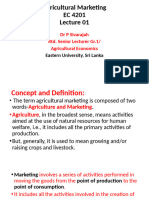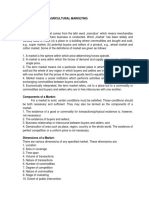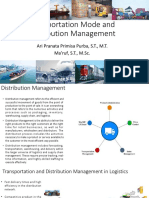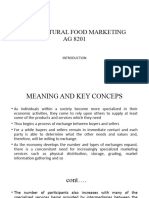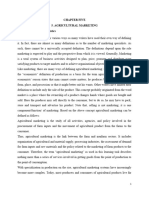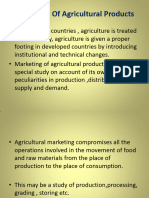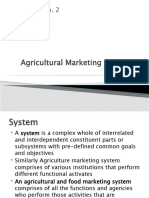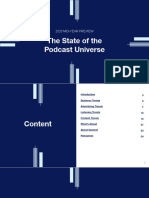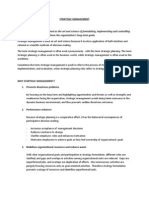0 ratings0% found this document useful (0 votes)
53 viewsAgricultural Marketing Is The Study of All The
Agricultural Marketing Is The Study of All The
Uploaded by
Njuguna ReubenThis document discusses agricultural marketing and different approaches to studying it. It covers the following key points:
1. Agricultural marketing involves all activities related to procuring farm inputs and moving farm products from producers to consumers.
2. Common approaches studied include the functional, institutional, commodity, and behavioral approaches.
3. The functional approach examines specific marketing functions like transportation, storage, buying, and selling. The institutional approach studies the agencies that perform marketing functions.
4. Storage and transportation are important physical supply functions that help make goods available when demanded and add value through place and time utility.
Copyright:
© All Rights Reserved
Available Formats
Download as PPT, PDF, TXT or read online from Scribd
Agricultural Marketing Is The Study of All The
Agricultural Marketing Is The Study of All The
Uploaded by
Njuguna Reuben0 ratings0% found this document useful (0 votes)
53 views39 pagesThis document discusses agricultural marketing and different approaches to studying it. It covers the following key points:
1. Agricultural marketing involves all activities related to procuring farm inputs and moving farm products from producers to consumers.
2. Common approaches studied include the functional, institutional, commodity, and behavioral approaches.
3. The functional approach examines specific marketing functions like transportation, storage, buying, and selling. The institutional approach studies the agencies that perform marketing functions.
4. Storage and transportation are important physical supply functions that help make goods available when demanded and add value through place and time utility.
Original Description:
Agriculture and marketing
Original Title
lesson 2
Copyright
© © All Rights Reserved
Available Formats
PPT, PDF, TXT or read online from Scribd
Share this document
Did you find this document useful?
Is this content inappropriate?
This document discusses agricultural marketing and different approaches to studying it. It covers the following key points:
1. Agricultural marketing involves all activities related to procuring farm inputs and moving farm products from producers to consumers.
2. Common approaches studied include the functional, institutional, commodity, and behavioral approaches.
3. The functional approach examines specific marketing functions like transportation, storage, buying, and selling. The institutional approach studies the agencies that perform marketing functions.
4. Storage and transportation are important physical supply functions that help make goods available when demanded and add value through place and time utility.
Copyright:
© All Rights Reserved
Available Formats
Download as PPT, PDF, TXT or read online from Scribd
Download as ppt, pdf, or txt
0 ratings0% found this document useful (0 votes)
53 views39 pagesAgricultural Marketing Is The Study of All The
Agricultural Marketing Is The Study of All The
Uploaded by
Njuguna ReubenThis document discusses agricultural marketing and different approaches to studying it. It covers the following key points:
1. Agricultural marketing involves all activities related to procuring farm inputs and moving farm products from producers to consumers.
2. Common approaches studied include the functional, institutional, commodity, and behavioral approaches.
3. The functional approach examines specific marketing functions like transportation, storage, buying, and selling. The institutional approach studies the agencies that perform marketing functions.
4. Storage and transportation are important physical supply functions that help make goods available when demanded and add value through place and time utility.
Copyright:
© All Rights Reserved
Available Formats
Download as PPT, PDF, TXT or read online from Scribd
Download as ppt, pdf, or txt
You are on page 1of 39
Agricultural Marketing
Agricultural marketing is the study of all the
activities, agencies and policies involved in the
procurement farm inputs by the farmer and
the movement of agricultural products from
the farmer to the consumers. It includes
organization of agricultural raw materials
supply to processing industries, the assessment
of demand for farm inputs and raw materials.
1
Marketing Functions
Approaches to the Study of Marketing
Marketing is a subject, which bristles with wide
and varied problems. It includes the services and
functions of different specialized institutions and
middlemen. Different commodities have special
marketing problems therefore the results of the
study of one commodity may not be applicable to
other commodity.
2
Functional Approach
A marketing function is an act, operation on service by
which the original producer and the final consumer are
linked producer and the final consumer are linked together.
Marketing consists of many operations and an operation
may be performed several times in the marketing process.
The functional approach splits down the field of marketing
into a few functions. This method analyses in detail the
specific functions of marketing such as buying, selling,
transportation, storage, standardization, grading, financing,
risk taking and marketing research.
3
The advantages of the functional approach in the
study of agricultural marketing problems are:
1. We can make inter functional comparison of the
marketing costs.
2. Inter agency comparison of the cost of performing
a marketing function can be made.
3. Inter commodity comparison of cost of
performing the various functions can also be
made.
4
The defects of this approach are
1. An undue emphasis on functions of
marketing does not permit one to know how
these functions are applied to specific
business operations.
2. The marketing functions are so numerous
that it is difficult to eliminate the
unnecessary from the necessary functions
5
6
I nstitutional Approach
The institutional approach to study of
marketing problems implies a study of
agencies and institutions, which perform
various functions in the marketing process.
The nature and character of various
middlemen and other related agencies
involved in the movement of the product are
studied.
7
8
These agencies vary widely in size and
ownership. They get their reward in the
form of marketing margins.
9
Commodity Approach
Under this approach, the commodity is the
pivot around which all institutional and
functional details are studied. The problems
of marketing differ from commodity to
commodity mainly because of the
seasonality of production, the variations in
its handling, storage, processing and the
number of middlemen involved in them.
10
For example potatoes are stored in cold
storage, while wheat is stored in godowns.
Paddy, pulses and oil seeds are processed at
miller's level. The main advantage of this
approach is that it is concrete since all work
relates to a specific product but it is a time
consuming 'process and often results in
excessive repetitions
11
Behavioural System Approach
This approach refers to the study of behaviour of
firms, institutions and organizations, which exist
in the marketing system for different commodities.
The marketing process is continually changing in
its organization and functional combinations. An
understanding of the behaviour of the individuals
is essential if changes in the behaviour and
functioning of the system are to be predicted.
12
Marketing Functions
Under the approaches to study of marketing we have seen
the marketing functions marketing functions can be
broadly classified as:
1. Functions of exchange which includes selling and buying.
2. Functions of physical supply, which consist of
transportation, storage and warehousing.
3. Facilitating functions, which comprise of financing, risk
taking, standardization and market information.
13
Functions of Exchange
The process of passing goods into the consumer's
hands is called function of exchange. It includes
buying, assembling and selling.
Buying and Assembling
Buying is the first step in the process of
marketing. Buying involves careful planning and
needs setting up of policies and procedures.
14
The following points are considered before a particular
product is bought.
What to buy (Product)?
1. When and how much to buy? (Time and
quantity)
2. From whom and where to buy? (Source)
3. On what terms and conditions and prices?
(Price)
15
Selling
The function of marketing is to ensure that the right
product is made available at the right place, in the right
quantity, at the right price, at the right time and under the
right impressions to the consumer. All these righteousness
is made possible by performing the sales function.
Through selling function desires are created hence it is
called as creative function. Selling is also often referred
to as distribution function because distribution makes
good move from the place of production to the place of
consumption. This is achieved through selling function.
16
Functions of Physical Supply
Functions of physical supply/distribution includes
determining warehouse locations '{establishing a
material handling system, maintaining an
inventory control system, establishing procedures
for processing orders) and selecting mode of
transportation. Transportation and storage account
for the major share in the total distribution cost.
17
Transportation
It is a necessary function of marketing
because the most of the markets are
geographically separated from the areas of
production. It enhances the economic
value through .creation of place utility.
The important function of transport is
18
1. It helps in the growth of industries whose products require quick
marketing e.g. vegetables, flowers, milk and fish.
2. It increases the demand for goods through widening of market
3. It creates place utility. As such transportation bridges the gap between
production and consumption centres.
4. By virtue of improvement in the speed of transport it offers time utility
to products.
19
5. It helps in stabilization of prices by moving commodities
from surplus area to deficit area.
6. Ensures even flow of goods Into the hands of consumers.
7. It enables to consumers to enjoy the benefits of many
goods not produced locally.
8. Transport intensifies competition, which, in turn, reduces
prices. Prices are also reduced because of the facilities
offered by transport for large-scale production.
20
Classification of transport
Road Transport
Merits : It is cheap, safe and flexible.
Demerits :It has got limited carrying capacity, slow speed, and unstable
rates.
Rail Transport
Merits : Most suitable for heavy and bulky commodities. Long distance is
quickly covered, cheap, all weather friend transport,
Demerits :Inflexibility, non suitable for local transport and lesser
accessibility.
Water Transport
Merits : Cheapest means of transport, high carrying capacity, creator of
international trade and especially suitable for certain areas (forest
products).
Demerits : Low speed, seasonal difficulties, longer journey required,
international and political problems and limited area of operation. 21
Air transport
Merits : Rapid speed, no barriers and boon to perishable commodities.
Demerits :High rate, low carrying capacity, dependence on climatic
conditions and high rate of accidents.
22
Problems in Transportation of Agricultural Commodities
1. The means of transport used are slow moving.
2. There are more losses/damages in transportation because the use of
poor packaging material, over loading of the produce, and poor
handling, especially, of fruits and vegetables at the time of loading
and unloading.
3. There is lack of co-ordination between different means of transport
e.g. railways and truck companies.
4. Non- availability of wagons at the time of harvest.
23
Suggestions for I mprovement
Some of the suggestions for effecting improvement in the transport function
and reducing the transport costs are
1. Full utilization of the transportation facility in terms of load. This will
reduce the per quintal cost of transportation.
2. Standardization of transport cost per quintal for different means.
3. Reduction in spoilage, damage, breakage and pilferage by better handling,
packing and the use of proper types of wagons.
24
4. Removal of barrier in the transport of agricultural
produce between states or regions.
5. The bulky agricultural produce can be converted into
value added products near production centres so there will
be reduction in cost.
6. The speed and capacity of the vehicles used in
transportation should be increased.
7. Unification of railway gauge system, extension of roads
and vehicles to every Village
25
Storage and Warehousing
Storage is an important marketing
function, which involves holding and
preserving goods from the time they are
produced until they are needed for
consumption.
26
The storage of agricultural produce/inputs is
necessary for the following reasons
1. Agricultural products are seasonally produced but are required for consumption
throughout the year.
2. Some goods are produced throughout the year but their demand is only seasonal
e.g. umbrella, fans, woolen clothes, agricultural inputs.
3. The quality of certain products increases by storing e.g. whisky, wine, tamarind,
rice, and pickles.
4. Storage of some farm commodities is necessary for ripening e.g. banana,
mango.
5. Storage protects the quality of perishable and semi-perishable products from
detoriation.
6. It helps in stabilization of price.
7. Storage is necessary for some periods for the performance of other marketing
functions.
27
Utilization of Warehouses by
Farmers
The storage capacity available under
different warehouses is furnished in Table
2.1. Only 29 percent of Central Ware
housing Corporation and six percent of the
State Ware "housing Corporations are used
by farmers or their co-operatives.
28
The main reasons for the very poor utilization of
warehouses by farmers are :
1. Lack of knowledge about available facilities to the farmers.
2. Location disadvantages.
3. Complicated and time-consuming procedure of depositing and
withdrawing the produce from the warehouses.
4. Non-availability of Nationalized banks at the villages to advance loans
against warehouse receipt.
5. Small quantity of surplus produce available with most farmers and the
pressing need for finance.
29
Facilitating Functions
Apart from function of exchange and function of physical
supply there is a third group of functions whose
involvement in the process of marketing is rather indirect
and remains as an undertone. Their importance and
necessity cannot be ignored because they are helpful in
minimizing various lags between production and
consumption created by time, place, quantity and quality
elements. These facilitating functions are financing, risk -
bearing standardization and marketing information.
30
Financing
Between production and consumption
ownership of commodities shifts many
times, middlemen need finance not only for
the purchase of stocks but for performance
of various marketing functions such as
processing, storage, packaging, transport
and grading. The process of arranging
necessary finance for marketing is termed
as "Marketing Finance".
31
Risk bearing / Taking
Risk in marketing may be defined as
uncertainty in regard to cost, loss, or
damage. The risks associated with the
marketing process are of three basic types.
32
Physical Risk
This includes a loss in the quantity and quality of the product during
marketing process. It may be due to fire, flood, earthquake, insects,
pests, fungus, excessive moisture or temperature, careless handling
unscientific storage, improper packing, looting and arson.
2. Price Risk
Prices change not only year to year, but also during month-to-month,
day-to-day or even on the same day.
3. Institutional Risk
These include risks arising out of changes in government's budget
policy, in tariffs and tax laws, in the movement restriction, statutory
price controls, and the imposition of levies.
33
Processing
The term processing may be defined a
deliberate activity which changes the form
of a commodity. It converts farm products
into a more usable form.
34
Advantages of processing
1. It changes raw food into edible and palatable form
2. By processing, the value addition to farm products is increased Sugarcane -
Sugar, gur
Wheat -Flour
Mango -Squash, Pulp, Past~ and Pickles
3. Processing function makes it possible for us to store perishable and semi-
perishable agricultural commodities for later use.
4 . It generates employment
5. It widens market
6. Processing serves as adjunct to other marketing functions such as transportation,
storage and merchandising.
35
Standardization
It means the determination of the standards
to be established for different commodities
Standards are fixed on the basis of certain
characteristics such as weight, size, colour
appearance, texture, moisture content,
amount of foreign matter present etc.
36
Grading
Sorting of the unlike lots of the produce into
different lots according to the quality
specifications laid down. Grading follows
standardization. It is a sub-function of
standardization.
37
Advantages of grading
1. Grading before sale enable farmers to get a higher
price for their produce.
2. Grading facilitates marketing
3. Grading widens market, without inspection the
sale can be effected over phone at distant places.
4. Grading helps consumers to get standard quality
products at fair price shops.
5. Grading contributes to market competition and
pricing efficiencies
38
bba411class@gmail.com
pword: agricmarketing
39
You might also like
- Distribution ManagementDocument20 pagesDistribution ManagementMatsouka Kou100% (3)
- Mar 2017Document76 pagesMar 2017deshmukhdpraveenNo ratings yet
- Customer Satisfaction Towards ITC ProductsDocument3 pagesCustomer Satisfaction Towards ITC ProductsAnkur Tiwari63% (8)
- Chap 2 - AGRICULTURAL MARKETING MEASUREMENT-editedDocument16 pagesChap 2 - AGRICULTURAL MARKETING MEASUREMENT-editedWinnie KhooNo ratings yet
- Unit 4 2Document22 pagesUnit 4 2ዘንገና ቲዩብNo ratings yet
- Lecture 01- Introdn to Agric MktgDocument23 pagesLecture 01- Introdn to Agric MktgJanath AnthonyNo ratings yet
- Econ & Marketing Ist LabDocument4 pagesEcon & Marketing Ist LabHardyesh ChandraNo ratings yet
- Pharmaceutical Marketing: Azhar Danish KhanDocument14 pagesPharmaceutical Marketing: Azhar Danish KhanAzhar Dk100% (3)
- Agri Chap 5Document14 pagesAgri Chap 5ኤደን DagneNo ratings yet
- Agricultural MarketingDocument140 pagesAgricultural MarketingDinukPereraNo ratings yet
- Agri Chap 5Document18 pagesAgri Chap 5ኤደን DagneNo ratings yet
- Chapter 5Document33 pagesChapter 5Sheeraz Ali SyedNo ratings yet
- Agricultural Marketing PDFDocument28 pagesAgricultural Marketing PDFAbegail VergaraNo ratings yet
- Agriculture Market Structure: By:-Dr. S. MahapatraDocument18 pagesAgriculture Market Structure: By:-Dr. S. MahapatraSambeet ParidaNo ratings yet
- Markt IntegrationDocument40 pagesMarkt IntegrationMD. IBRAHIM KHOLILULLAHNo ratings yet
- Physical DistributionDocument26 pagesPhysical DistributionsagarNo ratings yet
- Lesson 34 Processing and Marketing SubsystemDocument11 pagesLesson 34 Processing and Marketing SubsystemguerreromonchieNo ratings yet
- Supply ChainDocument9 pagesSupply Chainvishal gourNo ratings yet
- Agri Chapter 4Document51 pagesAgri Chapter 4Denaw AgimasNo ratings yet
- Agricultural Economics CH 4Document58 pagesAgricultural Economics CH 4Denaw AgimasNo ratings yet
- Agri Busreport 1 (1) FinalDocument27 pagesAgri Busreport 1 (1) FinalivypangubatanNo ratings yet
- Chapter 4: Agricultural MarketingDocument13 pagesChapter 4: Agricultural MarketingHaile GirmaNo ratings yet
- Chapt 1Document24 pagesChapt 1Jiregna BerbadaNo ratings yet
- Amtp Class 12 AprilDocument20 pagesAmtp Class 12 AprilPikku kumariNo ratings yet
- Agriculture MKTDocument60 pagesAgriculture MKTMukul Babbar100% (1)
- Lec-01 Agricultural MarketingDocument16 pagesLec-01 Agricultural MarketingMahida NavghanNo ratings yet
- Cooperative MarketingDocument20 pagesCooperative MarketingAparna SinghNo ratings yet
- Chapter 5 Intro To Agri MaketingDocument54 pagesChapter 5 Intro To Agri MaketingRosewinNo ratings yet
- Iabm 3Document4 pagesIabm 3Pratiksha GaikwadNo ratings yet
- LSCMDocument43 pagesLSCMnikhil98338971No ratings yet
- Sub Topic 2: Approaches To The Study of Agricultural MarketingDocument23 pagesSub Topic 2: Approaches To The Study of Agricultural MarketingRoberto GarciaNo ratings yet
- Lecture Notes: Agricultural Marketing Market: MeaningDocument60 pagesLecture Notes: Agricultural Marketing Market: MeaningBrentgreg DaumogNo ratings yet
- Transportation Mode & Distribution Management (Pertemuan VII)Document24 pagesTransportation Mode & Distribution Management (Pertemuan VII)Asep RahmatullahNo ratings yet
- PowerPoint For PresentationDocument28 pagesPowerPoint For PresentationBikila MitikuNo ratings yet
- AEC301 Online NotesDocument86 pagesAEC301 Online NotesAnanda PreethiNo ratings yet
- AGM Chapter (1-22) SummaryDocument96 pagesAGM Chapter (1-22) Summarywww.amitdevnath1No ratings yet
- Elements of Logistics Management NotesDocument52 pagesElements of Logistics Management NotesKamauWafulaWanyamaNo ratings yet
- Supply Chain ReviewerDocument4 pagesSupply Chain ReviewerRomelyn OrtalizaNo ratings yet
- Agricultural Food Marketing - NewDocument241 pagesAgricultural Food Marketing - Newhoseahosea2001No ratings yet
- Chapter Four: Agricultural MarketingDocument39 pagesChapter Four: Agricultural MarketingHaile GirmaNo ratings yet
- Lecture 03- _Mktg FunctionsDocument16 pagesLecture 03- _Mktg FunctionsJanath AnthonyNo ratings yet
- 2012 Ag. Marketing Power Point PresentationDocument45 pages2012 Ag. Marketing Power Point PresentationOliver TalipNo ratings yet
- Agricultural Marketing - AGB341 UNIT 6Document17 pagesAgricultural Marketing - AGB341 UNIT 6Mj MwansaNo ratings yet
- Agricultural Marketing ppt-1-3 2016Document149 pagesAgricultural Marketing ppt-1-3 2016anesahmedtofik932No ratings yet
- Chapter 9 - Physical DistributionDocument9 pagesChapter 9 - Physical DistributionKrisha ReyNo ratings yet
- Agricultural Market Price-1Document71 pagesAgricultural Market Price-1ዘንገና ቲዩብNo ratings yet
- MM unit-1 - mba22-24Document82 pagesMM unit-1 - mba22-24itskhushisharma18No ratings yet
- AGRICULTURAL MARKETING-Dr. L. R. DubeyDocument31 pagesAGRICULTURAL MARKETING-Dr. L. R. Dubeyjaydipsavaj68No ratings yet
- Pending-1639137516-Class On PlaceDocument27 pagesPending-1639137516-Class On PlaceTejesh ShamiNo ratings yet
- Elements of A Supply Chain NotesDocument21 pagesElements of A Supply Chain NotesJanhavi SNo ratings yet
- Agriculture EconomicsDocument24 pagesAgriculture EconomicsRudolfo OhNo ratings yet
- Physical Distribution: Marketing ManagementDocument6 pagesPhysical Distribution: Marketing ManagementShajina ShyjuNo ratings yet
- MKT2B Unit 1Document35 pagesMKT2B Unit 1blaze dollaNo ratings yet
- Marketing FunctionsDocument8 pagesMarketing FunctionsKavieswarNo ratings yet
- Introduction To Logistics ManagementDocument27 pagesIntroduction To Logistics ManagementFaisal Tanwar100% (4)
- Agri Chap 5Document13 pagesAgri Chap 5ኤደን DagneNo ratings yet
- Physical Distribution and Distribution Channels: Presented By: Lavina Garg, Mohd. Arfat, Priyesh BabbarDocument32 pagesPhysical Distribution and Distribution Channels: Presented By: Lavina Garg, Mohd. Arfat, Priyesh BabbarShukant7No ratings yet
- Marketing of Agricultural ProductsDocument23 pagesMarketing of Agricultural ProductsMI YashwantNo ratings yet
- Agricultural Marketing SystemDocument21 pagesAgricultural Marketing SystemM Umer SaeedNo ratings yet
- Logistics in Manufacturing, Supply Chain, and Distribution: The Supply Chain Journey, #1From EverandLogistics in Manufacturing, Supply Chain, and Distribution: The Supply Chain Journey, #1No ratings yet
- Procedure and Documentation in Supply Chain Management: Business strategy books, #1From EverandProcedure and Documentation in Supply Chain Management: Business strategy books, #1No ratings yet
- Brand Communicationa and LoyaltyDocument10 pagesBrand Communicationa and LoyaltyNjuguna ReubenNo ratings yet
- Nation 31 Mar 2016Document104 pagesNation 31 Mar 2016Njuguna ReubenNo ratings yet
- Introduction To Business-to-Business (B2B) Marketing/Industrial MarketingDocument14 pagesIntroduction To Business-to-Business (B2B) Marketing/Industrial MarketingNjuguna ReubenNo ratings yet
- BehaviorDocument24 pagesBehaviorNjuguna ReubenNo ratings yet
- Marketing Research: Lesson 3Document44 pagesMarketing Research: Lesson 3Njuguna ReubenNo ratings yet
- Types of CorrelationDocument6 pagesTypes of CorrelationNjuguna ReubenNo ratings yet
- Brand Loyalty Effect On Consumer ChoicesDocument14 pagesBrand Loyalty Effect On Consumer ChoicesNjuguna ReubenNo ratings yet
- Industrial Marketing (Week 2 and 3)Document20 pagesIndustrial Marketing (Week 2 and 3)Njuguna ReubenNo ratings yet
- Resume Vikash CCDocument1 pageResume Vikash CCDeepakNo ratings yet
- Group 6 - Analyse TOWS & BCG MatrixDocument9 pagesGroup 6 - Analyse TOWS & BCG MatrixAldi KurniawanNo ratings yet
- BDE StrategyDocument2 pagesBDE StrategyPG FIQNo ratings yet
- Felixberto Iso Sand Gravel and Hollow Blocks FactoryDocument13 pagesFelixberto Iso Sand Gravel and Hollow Blocks FactoryKxyz LightNo ratings yet
- Sample Feasibility Study FormatDocument4 pagesSample Feasibility Study FormatMae RxNo ratings yet
- 40 Project MayurDocument88 pages40 Project MayurSwapnil KadamNo ratings yet
- MM TCodeDocument14 pagesMM TCodesamir ChaudhariNo ratings yet
- Aditi 2Document13 pagesAditi 2Aditi PuriNo ratings yet
- Mahindra Partners - Logistics - Strategy To Go InternationalDocument2 pagesMahindra Partners - Logistics - Strategy To Go Internationalasdfg1987No ratings yet
- Voxnest 2020 Mid Year Preview ReportDocument24 pagesVoxnest 2020 Mid Year Preview ReportcdperiodismoNo ratings yet
- Hi-Tech MarketingDocument35 pagesHi-Tech MarketingPrabhakar KumarNo ratings yet
- Introduction To The Maruti Suzuki India LimitedDocument12 pagesIntroduction To The Maruti Suzuki India LimitedAnonymous PD7Pz6iNo ratings yet
- Correlation TraderDocument6 pagesCorrelation TraderThato Aphane100% (1)
- Marketing in Small CompaniesDocument19 pagesMarketing in Small CompaniesvinccycpNo ratings yet
- The Handbook for Supervisors - 保全監督者ハンドブックDocument38 pagesThe Handbook for Supervisors - 保全監督者ハンドブックSatria Adi Nugroho100% (1)
- Strategic Management CompleteDocument20 pagesStrategic Management Completeأبو ليلىNo ratings yet
- Unit-2 Retail Mgmt.Document28 pagesUnit-2 Retail Mgmt.sumeet kcNo ratings yet
- Preliminary Injunction Order - Lego v. Zuru (D. Conn. 2018)Document46 pagesPreliminary Injunction Order - Lego v. Zuru (D. Conn. 2018)Darius C. GambinoNo ratings yet
- The Cookie Factory I. Executive Summary: Eric Fain Brianna Wong Sydney WuDocument6 pagesThe Cookie Factory I. Executive Summary: Eric Fain Brianna Wong Sydney Wuapi-288350085No ratings yet
- PitchStock Universal Pitch Deck 06 4.3Document15 pagesPitchStock Universal Pitch Deck 06 4.3Suyash RajNo ratings yet
- Project Report On: Marketing Strategies of Oppo MobileDocument54 pagesProject Report On: Marketing Strategies of Oppo MobileerwinNo ratings yet
- ch05 PDFDocument100 pagesch05 PDFKara GamerNo ratings yet
- Asea Brown Boveri Case AnalysisDocument3 pagesAsea Brown Boveri Case Analysisrahul80795No ratings yet
- Presented By-AYUSH JAIN - 15005 Prashant Kumar-15017 Pushpender Singh-15021 Presented To - DR AbhilashaDocument16 pagesPresented By-AYUSH JAIN - 15005 Prashant Kumar-15017 Pushpender Singh-15021 Presented To - DR AbhilashaAyushJainNo ratings yet
- Partner Venture Capital in Boston MA Resume J. Carl MasiDocument2 pagesPartner Venture Capital in Boston MA Resume J. Carl MasiJCarlMasiNo ratings yet
- WalmartDocument9 pagesWalmartIqra IqraNo ratings yet
- Safari Batteries: Sales & Distribution AssignmentDocument6 pagesSafari Batteries: Sales & Distribution AssignmentMukesh BholNo ratings yet
- Sample BUSINESS PLAN EntrepDocument15 pagesSample BUSINESS PLAN Entrepmuhamidinamil2No ratings yet





